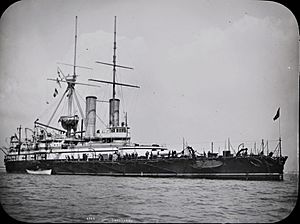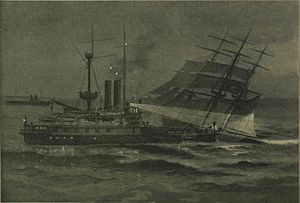HMS Sans Pareil (1887) facts for kids
 |
|
Quick facts for kids History |
|
|---|---|
| Name | HMS Sans Pareil |
| Builder | Thames Ironworks and Shipbuilding Company, Leamouth, London |
| Laid down | 21 April 1885 |
| Launched | 9 May 1887 |
| Commissioned | 8 July 1891 |
| Nickname(s) | Sans Pareil and her sister ship Victoria together were known as "The Pair of Slippers" |
| Fate | Sold for scrapping to Thos. W. Ward, 9 April 1907 |
| General characteristics | |
| Class and type | Victoria-class battleship |
| Displacement | 10,470 tons |
| Length | 370 ft (110 m) |
| Beam | 70 ft (21 m) |
| Draught | 26 ft 9 in (8.15 m) |
| Propulsion |
|
| Speed |
|
| Complement | 550 |
| Armament |
|
| Armour |
|
| Service record | |
| Part of: |
|
HMS Sans Pareil was a powerful battleship of the Royal Navy from the Victorian era. She was part of the Victoria-class, and her only sister ship was HMS Victoria. These two ships were sometimes called "The Pair of Slippers."
Sans Pareil was special because she was the last British battleship ever built with her main guns in a single turret. This turret was placed at the front of the ship. Older designs used "barbettes," which were open gun positions. The decision to go back to a turret was a bit unusual for the time.
Because the main guns were so heavy, both of them had to be placed together in one turret at the front. This helped keep the ship from being too heavy overall. To allow some firing power towards the back, a smaller 10-inch gun was placed there, protected by a light shield.
Design and Features
Sans Pareil was designed by Nathaniel Barnaby. She was a large ship, weighing about 10,470 tons. She was 370 ft (110 m) long and 70 ft (21 m) wide.
Her main weapons were two huge 16.25-inch guns. These were some of the biggest guns on any warship at the time! She also had a 10-inch gun at the back, twelve 6-inch guns, and smaller 6-pounder guns. For defense, she had thick armor, up to 18 in (46 cm) thick in some places, like her main belt and the turret.
The ship was powered by steam engines, which allowed her to reach speeds of up to 17.75 knots (32.87 km/h). She had a crew of 550 sailors.
Life at Sea: Service History

HMS Sans Pareil was officially ready for service on July 8, 1891, at Chatham. She first took part in some naval exercises, which are like practice battles.
From 1892 to 1895, she served with the Mediterranean Fleet. This fleet protected British interests in the Mediterranean Sea. After this, she became a "port guard ship" at Sheerness, meaning she helped protect the harbor.
In 1899, Sans Pareil had a refit, which means she was repaired and updated. She continued her duty as a guard ship until 1904. During this time, she was part of the Home Squadron, which toured with other guard ships.
In June 1902, she was docked in the Medway for a test of a new floating dock. She also took part in a big fleet review at Spithead on August 16, 1902. This was a special event to celebrate the coronation of King Edward VII.
In 1907, HMS Sans Pareil was sold for scrap. This happened as part of a plan by Admiral Fisher to modernize the Royal Navy fleet. She was taken apart at a dock in Preston, Lancashire.
A model of the ship, about 3 meters long, was saved from the ship before it was scrapped. This model is now on display at the Harris Museum and Library in Preston, where you can learn more about her story.



